My experiences of institutional meals have not been happy ones. In school, a large woman with forearms like hams, expression entirely free from the milk of human kindness, was employed by the nuns to ensure we choked down every scrap of granular, grey mash and leathery-skinned custard. In a flagship hospital, all gleaming glass and statement artworks, my bedside cupboard was filled with roast peppers, focaccia and salami from the Italian deli across the road because the beige, sloppy food trundled round at mealtimes made me feel sicker than I already was.
I was lucky enough to be able to afford to do that; many can't. Admittedly, it's a while since I was either at school or in hospital (and I'm yet to do porridge), but our institutions remain bywords for diabolical food. "School dinners" is still lobbed around as an insult by food writers (yes, me included), and both school and hospital catering continue to be the subject of lobbying bodies, online petitions and passionate reformers. In the prison service, bad food served to an audience already in poorer health than the general population has been shown to be a catalyst for aggression. Lord Ramsbotham, the former chief inspector of prisons, is on record as saying that he is "absolutely convinced there is a direct link between diet and antisocial behaviour".
Despite new government rules introduced last year dictating that hospital food should meet mandatory standards, including fish twice a week and seasonal produce, what's actually on offer can be terrifyingly dismal. Initiatives such as the Campaign for Better Hospital Food invite patients and their families to post pictures of the "slop" and "pigswill" served in the wards, a sorry cavalcade of greige unpleasantness. The site is peppered with miserable anecdotes of "cook-chill" food sent from manufacturers in Wales to hospitals in Yorkshire, and of traumatic weight loss by patients. Sustain, the body behind the crusade, also fronts the Children's Food Campaign, which maintains that, with poor school food and junk food, children's diets are in "crisis". It's clear that our most vulnerable people simply aren't being fed properly.
Many big names have tried to remedy the problem. Chef and Saturday Kitchen presenter James Martin has attempted to do for hospitals what Jamie Oliver did for schools, improving food standards " although Oliver's 2005 School Dinners programme had an unfortunate side-effect: the Turkey Twizzler furore turned even more parents on to packed lunches for their children, so canteens had to struggle harder to pay their way (the School Food Plan says "only 1% of packed lunches meet the overall nutritional standards that currently apply to school food"). But what happens once the celebrities and cameras move on?
I found a school, a hospital and an institute for young offenders where serious efforts are being made to ensure their food is far better than just about fit for purpose. I decided I was going to review them. Yes, a snooty restaurant critic, more used to eating ortolans and larks in oligarch-infested Mayfair, compelled to ingest institutional food. Would they survive? Would I?
"I'd happily serve this macaroni cheese to my family'
Royal Brompton hospital, London SW3
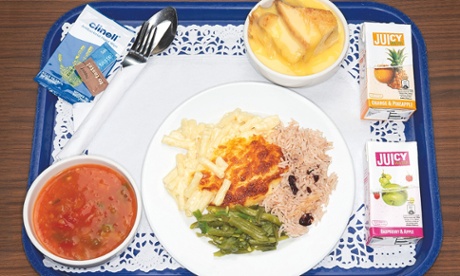
My jaw drops when cardiorespiratory dietician Ione Ashurst tells me that up to 40% of all hospital patients are admitted suffering from malnutrition. We are in Chelsea, one of the wealthiest of wealthy London's boroughs; I know its patients come from all over, but it's still hard to grasp.
There are a lot of things I haven't taken into account as I breeze in to try the food. The challenges of cooking for a large hospital are many and demanding. Of course they are. There's the more obvious stuff: budgets and scale and diets tailored to the hospital's specialisms. Royal Brompton is the largest heart and lung centre in the UK, meaning the food has to perform a very specific, curative and restorative function. Long-term patients can suffer from sarcopenia " age-related muscle wastage exacerbated by being bedridden " so protein in its most concentrated form is vitally important. But food also plays a hugely important psychological role: hours are long when you're lying ill abed, and a meal is not just sustenance, but one of the very few potentially pleasurable elements of interminable, monotonous days. It becomes something to look forward to in a way that even the loveliest lunch on the outside can never be.
Catering manager Paul Hammond, a former RAF chef, has a massive job on his hands. "We try to get extra protein into everything: milk powder into our fruit jellies, cheese in our mashed potato. We need them to eat." His budget for three full meals a day, plus afternoon tea, is "£3.50-"£4 per patient. It doesn't promise a great deal.
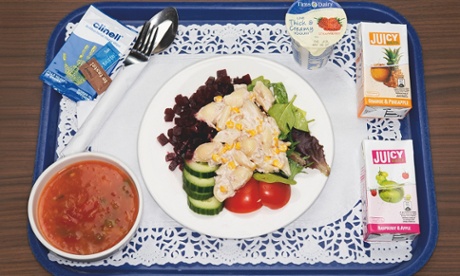
The first dish to arrive is a minestrone soup. Very little is bought in, most dishes are made fresh on the day, and the kitchen works through from early morning (this is very much not standard hospital catering practice). The soup is vivid with tomato and fresh vegetables, the stock slightly gloopy; they use a commercial base, but that is one of the kitchen's rare shortcuts, and soups themselves are freshly made. Calories are stealthily shoehorned into everything, so a salad of fresh leaves, cucumber and tomatoes, cut into teatime-at-your-nan's quarters, is topped with pasta shells liberally laced with rich tuna mayonnaise. It's never going to turn up on Instagram tagged #artofplating, but it's soothing and comforting.
Much of the food isn't as bland as I expected. There's a jerk chicken dish where the bird " farm-assured (over 30% of the hospital's produce is now local or organic or both, remarkable given that budget) " is coated in a sticky, treacly jerk glaze. Perhaps it's not spicy enough for my taste, but then I'm not recovering from major surgery. And it comes with Caribbean-style dirty rice studded with kidney beans, the grains fluffy and separate and fully flavoured. To get rice like this on an industrial scale is a genuine achievement. Yes, the green beans are cooked more thoroughly than I'd like, but in my experience older people enjoy their vegetables boiled to buggery.
The job the kitchens have here is Sisyphean. The menu changes on a three-weekly basis, ensuring the appetites of both short- and long-term patients are constantly stimulated. Then there are procedural headaches: overcoming the effects on food caused by long journeys between kitchen and ward in heated trolleys. But macaroni cheese is excellent: the pasta with substance and bite, the creamy, cheese-rich sauce with a fine, oven-baked crust. They've used decent cheddar. I'd happily serve this to my family for tea. I might not accompany it with a side order of rice, even though I'm not averse to a spot of double-carbing, but again, the need is there for calories.
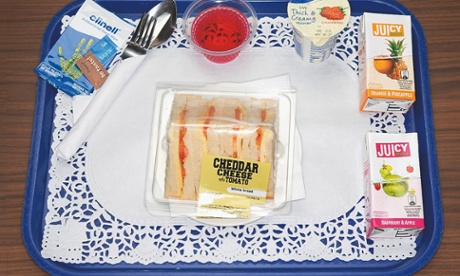
Seemingly inconsequential things matter: Hammond tells me they're about to change their sandwich packaging from the familiar corner shop-style Cellophane pack to a tray layout of four smaller triangles. It's about eye appeal, and also lets appetite-lacking patients reseal for later, after nibbling on a cheese and tomato on white. ("White?" I ask Ashurst. She smiles: "Wholegrain would fill them up too quickly. With white, they're likely to eat more.") Even bought-in items are scrupulously sourced: a thick, creamy, black cherry yoghurt has 4.2g of protein and is, of course, live.
I laugh that they don't need to worry about the likes of TripAdvisor, only to be told that patients are encouraged to feedback via weekly forms and forums. Which is why the teatime cake is a moist, homemade-tasting sponge, and why pies and pastries are made on site. For an operation that's walking the vertiginous tightrope between health issues and the need to please a hugely disparate demographic of "customers", while at the same time ticking all the boxes dictated by government standards, well, frankly, they do an amazing job.
"I have never been moved to tears by lunch, but I am now'
Hydebank Wood young offenders college, Belfast
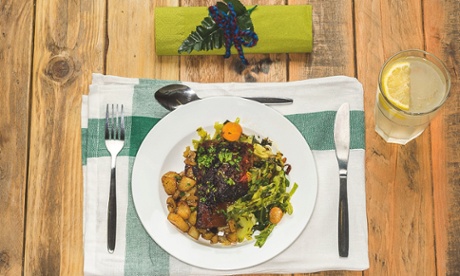
Security is, clearly, a priority. But in the airy, newly built reception of Northern Ireland's only youth prison, the machine designed to issue my pass has malfunctioned. So, rather than being allowed to walk through the bright, modern corridors, I have to go through a dingy concrete and metal holding pen, a decompression chamber between freedom and incarceration.
What was formerly known as Hydebank Wood Young Offenders Centre and Prison is changing. It's now a "secure college" with the emphasis firmly on education and rehabilitation, a place of hope rather than a house of correction. Cell blocks are "residential houses", inmates are "students". I'm here to review the Cabin Cafe, a new project set up by cook/restaurateur/writer Philip Dundas, where nine inmates " sorry, students " are effectively running a small cafe/restaurant. Customers are Hydebank Wood's staff.
"When I first suggested they eat food prepared by the prisoners," Dundas says, "the answer was, "It'll never happen.'" The restaurant also feeds fellow students: one boy is taking a break from grounds duties to enjoy a bowl of chicken and vegetable soup. ("Neverending soup," Dundas laughs. "We aim for little or no waste, so everything goes back in the pot.") The soup thrums with goodness: you can really taste the chicken, with a fresh backnote of lemon and the bright jab of black pepper. It comes with bread from Belfast's Yellow Door Deli (I'm forgiving the foil-wrapped pat of butter). When it first made an appearance, one of the boys marvelled, "I never knew bread could taste like that."
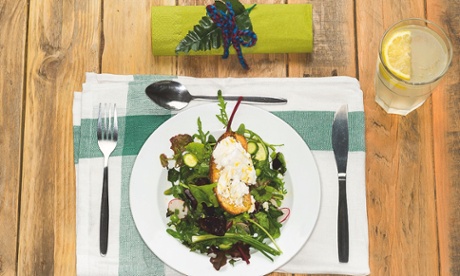
With input from the women's wing, they have done creative things with the boxy, municipal space, painting trompe l'oeil panelling on doors, and wallpapering with pages from vintage cookery and nutrition books. Basic furniture has been upcycled with help from the city's Studio Souk. The most attractive feature is the display of cakes and biscuits: orange shortbread, cornflake cookies, a genuinely flawless banoffee pie " rich, sticky, creamy top, crumbly base " all priced from 50p. The cafe has to be self-supporting, with any profits ploughed straight back. Sue McAllister, director general of the Northern Ireland prison service, who is in today with colleagues for lunch, tells me about one lovely, karmic source of income: revenue from assets recovery or, as McAllister says, "The money from baddies."
Behind the counter, they're plating up goat's cheese on croutons with salad, the cheese donated by a neighbouring farmer who's also in line to supply the institution with its own goats. The salad is first class: wonderfully perky leaves, mandolined radish and raw courgette, tiny, sweet peas, chard " all grown in the many polytunnels just outside. Presentation is beautiful, a youthful spring onion lolling over the top, nasturtiums dotted about. Today's main dish is short ribs, or Jacob's ladder as they're known by Jason at Carnbrooke, the butcher who supplies them at a generous discount. It's fine meat, too, Dexter beef, slumping off the bone, in a sauce fragrant with orange peel. "We put them in the warming drawer overnight," Dundas says. "The smell when you come down in the morning is amazing." Vegetables are all from the garden, and they're restaurant quality. I speak to the young guy serving me. Has working here changed his attitude to food? "Oh yes," he shakes his head in wonder. "I didn't have a clue. I didn't even know it took just minutes to make an omelette."
The boys seem a little nervous, but smiley and friendly. There are five working today " they self-select and do their own rotas, helped by Nicky Orr, who has moved over from the unit's conventional canteen. McAllister points at the youth manning the coffee machine. "He volunteered to come in and cover another lad who was unable to make it. Volunteered," she emphasises. "This never happens in a prison environment. Never."
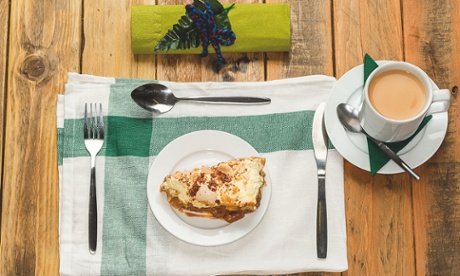
I ask how she and Dundas connected. It was via the networking website LinkedIn, surely the first instance of anything valuable ever coming from there. She continues: "The change in these boys in a matter of weeks is amazing. Their eyes are brighter, their shoulders straighter. They now look you in the eye." I have never been moved to tears by lunch (unless you count Gregg Wallace's restaurants), but I am now.
Dundas echoes McAllister's observations. "I absolutely believe you can cultivate emotional intelligence through diet. There was a"... situation earlier. A few weeks ago it might not have ended so well, but today they simply sorted it out between them and moved on." The students are in charge of the only metal cutlery allowed in the unit ("They count it religiously each evening and panic if anything has gone missing."). And the till. Not once, Dundas says, has it ever been anything other than dead on the money. Often, these young men have grown up in poverty and nutritional deprivation, with the relentless stress those entail. And stress hormones inhibit cognitive functions: planning, attention and, crucially, emotional control.
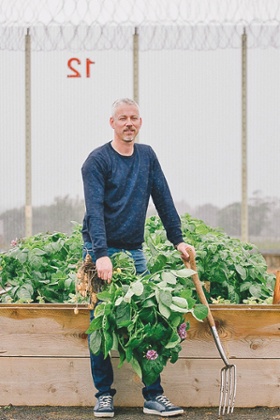
The cafe's staff have been involved in every step of the process, from naming it to their uniforms (all black, with The Cabin Crew on the back), to their loyalty scheme " in a deliberately comic touch, it uses fingerprints. Mutually agreed rules of engagement decorate the counter: "I will always turn up on time, ready to start work with a smile." They're absorbing skills that could be hugely valuable to them in the outside world. McAllister and Dundas are hoping to transform disused stables owned by the unit into a Northern Ireland food hub, with major input from the students; they'd love to see Hydebank Wood become a test case. They see no reason why prisoners (some of whom can work "outside") shouldn't provide meals on wheels services, or feed the homeless.
As I leave, the lads sit down to a lunch they've helped grow, prepare and serve, and call on Dundas to join them. I ask one if the boss shouts and swears in the kitchen, as chefs famously do. "Oh no," he laughs. "He knows what he's doing, so he does." The whole experience has been completely uplifting for me. I can only imagine what it's like for them.
"This is very different from the cabbage reek I remember'
Gayhurst community school, London E8
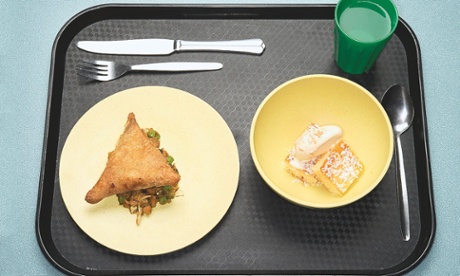
The first thing that strikes me as I'm buzzed through the gates of the handsome, red-brick Gayhurst school in Hackney, east London, is the aroma. Walking past a splashily painted planter of herbs, I breathe in the fragrance of garlic and spices " very different from the damp cabbage reek I associate with school dinner halls.
Inside, I'm shown to my seat at the end of a long, communal table under the baleful gaze of an enormous cardboard robot. On the table are boards laden with chopped avocado and cucumber salad, and labneh laced with orange blossom water. "It's one of my cheffy touches," admits Nicole Pisani, the former head chef of Yotam Ottolenghi's Nopi, who caused waves when she left that high-profile gig to take over the school's canteen. "I love working here and seeing the kids eat our food, but there has to be something in it for me, too."
Pisani applied for the job following a tweet from Henry Dimbleby, co-founder of Leon and architect of the School Food Plan, saying that his son's school was in need of a cook. School hours allow Pisani a quality of life " "I get to see my friends!" " and work on other projects in the holidays. But, watching her talking to the children as they clear their plates, it's obvious she is utterly committed to the job. "I stand by the bins so I can hear what they're saying," she says. "But, just as importantly, I can see exactly what they're eating."
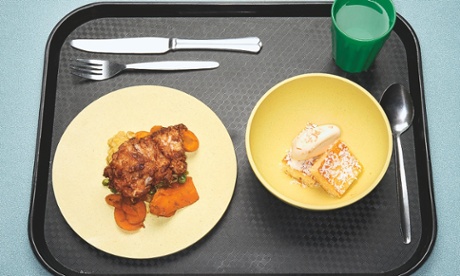
Today's main dish is fried chicken, given exactly the same treatment as it gets in those cool, brick-walled restaurants: brined, marinated in buttermilk and fried at the last minute. (Other dishes might be Vietnamese beef noodles, or homemade fish fingers. "We try to do healthy versions of the kind of thing they love to eat," Pisani says. "I asked one child what her favourite vegetable was and she said "chicken nuggets'.") Her fried chicken is gorgeous, the meat tender and moist, steam rising from its crisp coating. It sits on tandoori-style carrots and peas, and gently spiced coconut dhal. I hear one junior wag, clearly alarmed at this novelty, bellowing to his pals, "Don't eat that!" His loss.
Since I'm trying everything, I intend to have only a bite or two of each dish. But faced with a vegetable samosa, the thin, crisp pastry homemade, the spices subtly insistent, finished with a flourish of that avocado salad on top and Indian-style chickpeas beneath " all the work of Pisani's colleagues Samia, Zahra and Hodan " I find myself polishing off the lot. There's homemade coconut sponge, topped with silky, rich vanilla ice-cream made by Cheryl, formerly a chef at the Riding House Cafe. You'd never guess that this was food plonked on to plastic plates from huge metal catering trays. The staff all dress in chef's whites, and address each other as chef. And why not?
The children are dolloping the avocado on their plates; at the end of lunch, it's been demolished. "If we handed it to them, they'd leave it," Pisani says, "but left to help themselves, it all goes." The salad is the work of Elizabeth, 75, who's worked as a dinner lady for decades. She's a total convert to the new system. "She'll now tell me off," Pisani says, "especially if she thinks something lacks colour."
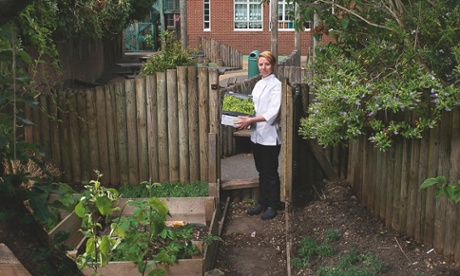
Headteacher Louise Nichols is planning to phase out packed lunches completely towards the end of the year. Wow, that's brave. Nichols smiles: "We like a challenge." Something else they're phasing out is the prison-style, compartmented plastic food trays, in favour of actual plates, made of recycled material. Eating food at school, they reckon, should reflect the real experience of dining as closely as possible.
Feedback from parents is almost universally positive. Since Dimbleby was instrumental, I ask what he thinks. "The change Pisani has brought about is extraordinary," he says. "She has focused on encouraging children to eat more broadly. And, critically, while bringing down food costs, because they're wasting less and eating more vegetables. I hope more chefs are inspired by what she's doing, to think of cooking in schools as a serious career option."
Pisani's energy is incredible. As is her food " done for a ridiculous 85p a head per day. (She expresses her discomfort at a London restaurant scene where bills routinely hit "£300 for two.) Never mind me, though; the biggest critics are the kids. At the end of lunch, they fill a tub with either green ping-pong balls (like) or yellow (don't like). Feedback doesn't get more instant. Yes, there are yellow ones in there " older children, with more entrenched tastes, are more resistant to change than the little ones " but green wins the day. And they're learning to embrace the likes of chicken in soy, penne pesto and aubergine parmigiana. Bite that, chicken nuggets.









